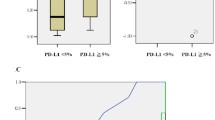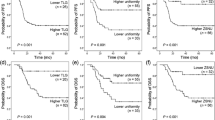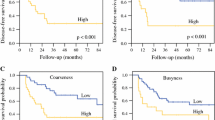Abstract
Purpose
This study investigated the correlation of the matrix heterogeneity of tumors on 18F-fluorodeoxyglucose positron emission tomography–computed tomography (PET–CT) with gene-expression profiling in patients with pharyngeal cancer and determined the prognostic factors for radiotherapy-based treatment outcomes.
Methods
We retrospectively reviewed the records of 57 patients with stage III–IV oropharyngeal or hypopharyngeal cancer who had completed definitive therapy. Four groups of the textural features as well as 31 indices were studied in addition to maximum standard uptake value, metastatic tumor volume, and total lesion glycolysis. Immunohistochemical data from pretreatment biopsy specimens (Glut1, CAIX, VEGF, HIF-1α, EGFR, Ki-67, Bcl-2, CLAUDIN-4, YAP-1, c-Met, and p16) were analyzed. The relationships between the indices and genomic expression were studied, and the robustness of various textural features relative to cause-specific survival and primary relapse-free survival was analyzed.
Results
The overexpression of VEGF was positively associated with the increased values of the matrix heterogeneity obtained using gray-level nonuniformity for zone (GLNUz) and run-length nonuniformity (RLNU). Advanced T stage (p = 0.01, hazard ratio [HR] = 3.38), a VEGF immunoreactive score of >2 (p = 0.03, HR = 2.79), and a higher GLNUz value (p = 0.04, HR = 2.51) were prognostic factors for low cause-specific survival, whereas advanced T stage, a HIF-1α staining percentage of ≥80%, and a higher GLNUz value were prognostic factors for low primary-relapse free survival.
Conclusions
The overexpression of VEGF was associated with the increased matrix index of GLNUz and RLNU. For patients with pharyngeal cancer requiring radiotherapy, the treatment outcome can be stratified according to the textural features, T stage, and biomarkers.



Similar content being viewed by others
Abbreviations
- 18F-FDG:
-
18F-fluorodeoxyglucose
- CRT:
-
Chemoradiotherapy
- CTVs:
-
Clinical target volumes
- GLNUz:
-
Gray-level nonuniformity for zone
- GTV:
-
Gross tumor volume
- HNSCC:
-
Head and neck squamous cell carcinoma
- HPV:
-
Human papilloma virus
- MTV:
-
Metastatic tumor volume
- PET/CT:
-
Positron emission tomography-computed tomography
- RLNU:
-
Run-length nonuniformity
- RT:
-
Radiotherapy
- SUV:
-
Standardized uptake value
- TLG:
-
Total lesion glycolysis
References
Hanahan D, Weinberg RA. Hallmarks of cancer: the next generation. Cell. 2011;144:646–74.
Gerlinger M, Swanton C. How Darwinian models inform therapeutic failure initiated by clonal heterogeneity in cancer medicine. Br J Cancer. 2010;103:1139–43.
Tixier F, Le Rest CC, Hatt M, Albarghach N, Pradier O, Metges JP, et al. Intratumor heterogeneity characterized by textural features on baseline 18F-FDG PET images predicts response to concomitant radiochemotherapy in esophageal cancer. J Nucl Med. 2011;52:369–78.
Vaidya M, Creach KM, Frye J, Dehdashti F, Bradley JD, El Naqa I. Combined PET/CT image characteristics for radiotherapy tumor response in lung cancer. Radiother Oncol. 2012;102:239–45.
Tan S, Kligerman S, Chen W, Lu M, Kim G, Feigenberg S, et al. Spatial-temporal [18 F]FDG-PET features for predicting pathologic response of esophageal cancer to neoadjuvant chemoradiation therapy. Int J Radiat Oncol Biol Phys. 2013;85:1375–82.
Cook GJ, Yip C, Siddique M, Goh V, Chicklore S, Roy A, et al. Are pretreatment 18F-FDG PET tumor textural features in non-small cell lung cancer associated with response and survival after chemoradiotherapy? J Nucl Med. 2013;54:19–26.
Hatt M, Majdoub M, Vallières M, Tixier F, Le Rest CC, Groheux D, et al. 18F-FDG PET uptake characterization through texture analysis: investigating the complementary nature of heterogeneity and functional tumor volume in a multi-cancer site patient cohort. J Nucl Med. 2015;56:38–44.
Ohri N, Duan F, Snyder BS, Wei B, Machtay M, Alavi A, et al. Pretreatment 18FDG-PET textural features in locally advanced non-small cell lung cancer: secondary analysis of ACRIN 6668/RTOG 0235. J Nucl Med. 2016;57:842–8.
Yang F, Thomas MA, Dehdashti F, Grigsby PW. Temporal analysis of intratumoral metabolic heterogeneity characterized by textural features in cervical cancer. Eur J Nucl Med Mol Imaging. 2013;40:716–27.
Cheng NM, Fang YH, Lee LY, Chang JT, Tsan DL, Ng SH, et al. Zone-size nonuniformity of 18F-FDG PET regional textural features predicts survival in patients with oropharyngeal cancer. Eur J Nucl Med Mol Imaging. 2015;42:419–28.
Wang HM, Cheng NM, Lee LY, Fang YH, Chang JT, Tsan DL, et al. Heterogeneity of (18) F-FDG PET combined with expression of EGFR may improve the prognostic stratification of advanced oropharyngeal carcinoma. Int J Cancer. 2016;138:731–8.
Orlhac F, Soussan M, Maisonobe JA, Garcia CA, Vanderlinden B, Buvat I. Tumor texture analysis in 18F-FDG PET: relationships between texture parameters, histogram indices, standardized uptake values, metabolic volumes, and total lesion glycolysis. J Nucl Med. 2014;55:414–22.
Alobaidli S, McQuaid S, South C, Prakash V, Evans P, Nisbet A. The role of texture analysis in imaging as an outcome predictor and potential tool in radiotherapy treatment planning. Br J Radiol. 2014;87:1042.
Ang KK, Harris J, Wheeler R, Weber R, Rosenthal DI, Nguyen-Tân PF, et al. Human papillomavirus and survival of patients with oropharyngeal cancer. N Engl J Med. 2010;363:24–35.
Akervall J, Nandalur S, Zhang J, Qian CN, Goldstein N, Gyllerup P, et al. A novel panel of biomarkers predicts radioresistance in patients with squamous cell carcinoma of the head and neck. Eur J Cancer. 2014;50:570–81.
Lallemant B, Evrard A, Chambon G, Sabra O, Kacha S, Lallemant JG, et al. Gene expression profiling in head and neck squamous cell carcinoma: clinical perspectives. Head Neck. 2010;32:1712–9.
Vordermark D, Brown JM. Endogenous markers of tumor hypoxia predictors of clinical radiation resistance? Strahlenther Onkol. 2003;179:801–11.
Kumar B, Cordell KG, Lee JS, Worden FP, Prince ME, Tran HH, et al. EGFR, p16, HPV titer, Bcl-xL and p53, sex, and smoking as indicators of response to therapy and survival in oropharyngeal cancer. J Clin Oncol. 2008;26:3128–37.
Smith BD, Smith GL, Carter D, Sasaki CT, Haffty BG. Prognostic significance of vascular endothelial growth factor protein levels in oral and oropharyngeal squamous cell carcinoma. J Clin Oncol. 2000;18:2046–52.
Brown JM, William WR. Exploiting tumour hypoxia in cancer treatment. Nat Rev Cancer. 2004;4:437–47.
Kyzas PA, Stefanou D, Batistatou A, Agnantis NJ. Prognostic significance of VEGF immunohistochemical expression and tumor angiogenesis in head and neck squamous cell carcinoma. J Cancer Res Clin Oncol. 2005;131:624–30.
Klimowicz AC, Bose P, Petrillo SK, Magliocco AM, Dort JC, Brockton NT. The prognostic impact of a combined carbonic anhydrase IX and Ki-67 signature in oral squamous cell carcinoma. Br J Cancer. 2013;109:1859–86.
Hong A, Dobbins T, Lee CS, Jones D, Jackson E, Clark J, et al. Relationships between epidermal growth factor receptor expression and human papillomavirus status as markers of prognosis in oropharyngeal cancer. Eur J Cancer. 2010;46:2088–96.
Couture C, Raybaud-Diogène H, Têtu B, Bairati I, Murry D, Allard J, et al. p53 and Ki-67 as markers of radioresistance in head and neck carcinoma. Cancer. 2002;94:713–22.
Chen SW, Hsieh TC, Yen KY, Liang JA, Kao CH. Pretreatment 18F-FDG PET/CT in whole body total lesion glycolysis to predict survival in patients with pharyngeal cancer treated with definitive radiotherapy. Clin Nucl Med. 2014;39:e296–300.
Nestle U, Kremp S, Schaefer-Schuler A, Sebastian-Welsch C, Hellwig D, Rübe C, et al. Comparison of different methods for delineation of 18F-FDG PET-positive tissue for target volume definition in radiotherapy of patients with non-small cell lung cancer. J Nucl Med. 2005;46:1342–8.
Haralick RM, Shanmugam K, Dinstein I. Textural features for image classification. IEEE Trans Syst Man Cybern. 1973;3:610–21.
Sun C, Wee WG. Neighboring gray level dependence matrix for texture classification. Comput Vis Graph Image Process. 1983;23:341–52.
Loh H, Leu J, Luo R. The analysis of natural textures using run length features. IEEE Trans Ind Electron. 1988;35:323–8.
Thibault G, Fertil B, Navarro C, Pereira S, Cau P, Levy N, et al. Texture indexes and gray level size zone matrix: application to cell nuclei classification. Pattern Recogn Inf Process. 2009;140–145.
Lin SC, Liao CY, Kao CH, Yen KY, Yang SN, Wang YC, et al. Pretreatment maximal standardized uptake value of the primary tumor predicts outcome to radiotherapy in patients with pharyngeal cancer. J Radiat Res. 2012;53:462–8.
Lambin P, Rios-Velazquez E, Leijenaar R, Carvalho S, van Stiphout RG, Granton P, et al. Radiomics: extracting more information from medical images using advanced feature analysis. Eur J Cancer. 2012;48:441–6.
Brooks FJ. On some misconceptions about tumor heterogeneity quantification. Eur J Nucl Med Mol Imaging. 2013;40:1292–4.
Nyflot MJ, Kruser TJ, Traynor AM, Khuntia D, Yang DT, Hartig GK, et al. Phase 1 trial of bevacizumab with concurrent chemoradiation therapy for squamous cell carcinoma of the head and neck with exploratory functional imaging of tumor hypoxia, proliferation, and perfusion. Int J Radiat Oncol Biol Phys. 2015;91:942–51.
Fleming IN, Manavaki R, Blower PJ, West C, Williams KJ, Harris AL, et al. Imaging tumour hypoxia with positron emission tomography. Br J Cancer. 2015;112:238–50.
Welsh L, Panek R, McQuaid D, Dunlop A, Schmidt M, Riddell A, et al. Prospective, longitudinal, multi-modal functional imaging for radical chemo-IMRT treatment of locally advanced head and neck cancer: the INSIGHT study. Radiat Oncol. 2015;10:112.
Author’s contributions
SW Chen, WC Shen, and CH Kao were responsible for design of the study. All authors collected the data. SW Chen, WC Shen, and CH Kao carried out statistical analysis, interpretation of data, and drafting the article. All authors provided some intellectual content. SW Chen, WC Shen, and CH Kao approved the version to be submitted. All authors read and approved the final manuscript.
Author information
Authors and Affiliations
Corresponding author
Ethics declarations
Funding
This study was supported in part by China Medical University Hospital (DMR-104-041), Ministry of Science and Technology (NSC 100-2221-E-468-003 and MOST 105-5518-E-009-034), Taiwan; the Taiwan Ministry of Health and Welfare Clinical Trial and Research Center of Excellence (MOHW105-TDU-B-212-133019); China Medical University Hospital, Academia Sinica Taiwan Biobank Stroke Biosignature Project (BM10501010037); NRPB Stroke Clinical Trial Consortium (MOST 105-2325-B-039-003); Tseng-Lien Lin Foundation (Taichung, Taiwan), Taiwan Brain Disease Foundation (Taipei, Taiwan), and Katsuzo and Kiyo Aoshima Memorial Funds, Japan; CMU under the Aim for Top University Plan of the Ministry of Education, Taiwan; and the Welfare Surcharge of Tobacco Products, China Medical University Hospital Cancer Research Center of Excellence (MOHW105-TDU-B-212-134-003, Taiwan). The funders had no role in the study design, data collection and analysis, decision to publish, or preparation of the manuscript. No additional external funding was received for this study.
Conflict of interest
Shang-Wen Chen declares that he/she has no conflict of interest. Wei-Chih Shen declares that he/she has no conflict of interest. Ying-Chun Lin declares that he/she has no conflict of interest. Rui-Yun Chen declares that he/she has no conflict of interest. Te-Chun Hsieh declares that he/she has no conflict of interest. Kuo-Yang Yen declares that he/she has no conflict of interest. Chia-Hung Kao declares that he/she has no conflict of interest.
Ethical approval
This study was approved by a local institutional review board (CMUH103-REC2-093FR).
Informed consent
The IRB also specifically waived the consent requirement.
Additional information
Shang-Wen Chen and Wei-Chih Shen contributed equally to this work.
Appendices
Appendix 1. Representative images of immunohistochemistry for HIF-1α, VEGF, and Glut1

Appendix 2
Appendix 3
Appendix 4. Detailed data on the role of VEGF in pharyngeal cancer regarding to the textural features and treatment outcome
-
1)
Primary relapse-free survival in patients who had tumors with a VEGF IRS of >2 and ≤2 (p = 0.002).

-
2)
Cause-specific survival in oropharyngeal cancer patients who had tumors with a VEGF IRS of >2 and ≤2 (p = 0.005 and p = 0.006, respectively).

-
3)
Table
Indices calculated from the textural analysis and the area under the ROC curve for predicting the expression of VEGF using a cutoff of IRS >2 vs. ≤2.
Classification of matrix
Index
Area under the curve
CT-based volume
GTV
0.75 ± 0.07
Classical PET-related parameter
SUVmax
0.57 ± 0.08
Gray-level co-occurrence matrix (GLCM)
MTV2.5
0.71 ± 0.09
TLG40%
0.61 ± 0.10
Homogeneity
0.44 ± 0.08
Energy
0.31 ± 0.08
Correlation
0.55 ± 0.10
Contrast
0.61 ± 0.08
Entropy
0.67 ± 0.08
Dissimilarity
0.61 ± 0.08
Gray-level run length matrix (GLRLM)
SRE
0.53 ± 0.09
LRE
0.49 ± 0.09
LGRE
0.37 ± 0.08
HGRE
0.61 ± 0.08
SRLGE
0.37 ± 0.08
SRHGE
0.60 ± 0.08
LRLGE
0.39 ± 0.08
LRHGE
0.64 ± 0.07
GLNUr
0.66 ± 0.09
RLNU
0.70 ± 0.09
RP
0.65 ± 0.09
Neighborhood gray-level different matrix (NGLDM)
Coarseness
0.31 ± 0.09
Contrast
0.38 ± 0.09
Busyness
0.51 ± 0.09
Gray-level zone length matrix (GLSZM)
SZE
0.51 ± 0.09
LZE
0.57 ± 0.09
LGZE
0.37 ± 0.08
HGZE
0.61 ± 0.08
SZLGE
0.34 ± 0.08
SZHGE
0.57 ± 0.08
LZLGE
0.53 ± 0.08
LZHGE
0.65 ± 0.10
GLNUz
0.72 ± 0.08
ZLNU
0.67 ± 0.08
ZP
0.48 ± 0.09
Appendix 5 The GLNUz value exhibited superior discrimination of local recurrence in patients with T3–T4 disease (n = 32). The 2-year PRFS for those with a GLNUz value in the >50th and ≤50th percentile was 10% and 84%, respectively (p < 0.001)

Rights and permissions
About this article
Cite this article
Chen, SW., Shen, WC., Lin, YC. et al. Correlation of pretreatment 18F-FDG PET tumor textural features with gene expression in pharyngeal cancer and implications for radiotherapy-based treatment outcomes. Eur J Nucl Med Mol Imaging 44, 567–580 (2017). https://doi.org/10.1007/s00259-016-3580-5
Received:
Accepted:
Published:
Issue Date:
DOI: https://doi.org/10.1007/s00259-016-3580-5








